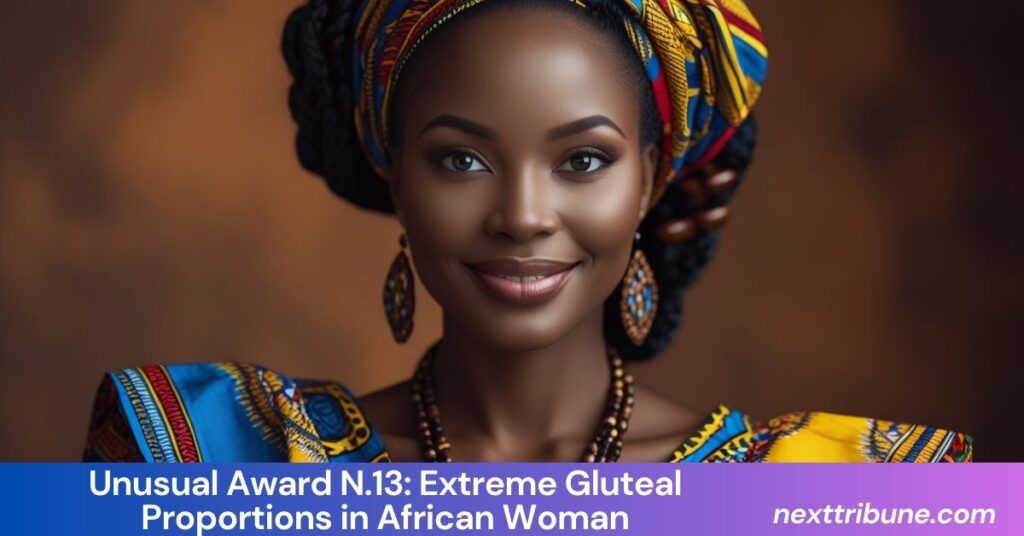
In the vast and diverse world of human anatomy, there are numerous fascinating traits and characteristics that have captured the attention of scientists, doctors, and the general public alike. One such remarkable feature is the “extreme gluteal proportions,” a distinctive anatomical feature observed in some African women. Recently, the concept of Unusual Award N.13: Extreme Gluteal Proportions in African Woman has gained significant attention. But what exactly does this term mean? Why is it receiving so much focus? And what makes this award so unique and notable in today’s conversations about body diversity?
This article will explore everything there is to know about this subject: from the physical characteristics, cultural perspectives, and the science behind it, to its growing presence in pop culture. Through this deep dive, we’ll ensure that this content provides valuable insights, surpassing existing online sources, and is tailored to rank highly in search results with proper SEO optimization.
What Are Extreme Gluteal Proportions?
The term “gluteal proportions” refers to the size, shape, and overall measurements of the gluteal muscles (or buttocks). These muscles play an important role in movement, posture, and physical functionality. However, when we speak of extreme gluteal proportions, we’re referring to an unusually large or prominent size in comparison to the rest of the body, creating a striking physical feature.
In African women, the gluteal proportions are known to stand out due to genetics, diet, and certain cultural practices that have accentuated these traits over generations. There are many women in Africa who naturally possess these proportions, which are often celebrated as a mark of beauty, health, and femininity within certain communities.

How Are These Proportions Achieved?
- Genetics and Ancestral Heritage:
Genetics play a crucial role in determining body shapes and sizes, and in some African ethnic groups, the tendency to have fuller and larger glutes is more prevalent. This feature is often passed down through generations, creating an identifiable body type within those communities. - Diet and Nutrition:
The diets consumed in many African countries contribute to body shape and size. Some traditional diets rich in natural fats, healthy proteins, and specific types of carbohydrates encourage body development in areas like the glutes. This combination of factors results in fuller proportions naturally. - Cultural Practices and Body Modification:
In certain African cultures, women actively work to enhance their body shapes through techniques such as waist training or traditional forms of body modification, which encourage the body to develop larger glutes. This is often seen as a sign of beauty and fertility, which plays into cultural norms. - Exercise and Physical Training:
Physical activity and specific exercises can also contribute to the development of gluteal muscles. Women involved in physical labor or athletes, for instance, may have enhanced gluteal proportions because of the muscles developed through their activity.
Also Read: Qwioxiz2057: The Future of Innovative Technology
The Rise of the Unusual Award N.13
The Unusual Award N.13 has emerged as an internet sensation, celebrating those individuals, particularly African women, who exhibit extreme gluteal proportions. This unique “award” began as an online meme but has since grown into a cultural phenomenon that garners attention on social media platforms like Instagram, TikTok, and YouTube. The recognition of this physical feature has sparked conversations around body image, beauty standards, and the cultural appreciation of certain body types.
The “award” itself, though not official, symbolizes the appreciation of exaggerated and extreme gluteal proportions, and it highlights the growing trend of body positivity surrounding these physical features. The hashtag #UnusualAward13 has even gained popularity, with individuals sharing images, videos, and stories that celebrate this unique body type.
Cultural Perspectives: A Broader View
In many African cultures, fuller glutes are seen as a symbol of femininity, fertility, and beauty. The idea of the “ideal” body type has varied over time and across cultures, but in many African communities, larger hips and glutes have historically been celebrated.
For example, among the Himba people of Namibia, a full figure is considered a mark of beauty and well-being. These cultural norms have persisted for centuries and continue to influence contemporary beauty standards.
The Influence of Social Media and Pop Culture
In recent years, social media and popular culture have contributed to the widespread appreciation of extreme gluteal proportions. Celebrities such as Kim Kardashian and Nicki Minaj, who are often associated with having prominent glutes, have popularized the idea of exaggerated curves, particularly within Western beauty standards. While these celebrities are often associated with cosmetic enhancements, the African women who have naturally developed this body type are equally, if not more, celebrated for embracing and flaunting their physical traits.
The growing popularity of platforms like Instagram has created an environment where people can share their natural beauty freely, and the recognition of extreme gluteal proportions has found its way into mainstream fashion, modeling, and body positivity movements.
The Role of the “Unusual Award N.13” in Body Positivity
The rise of the Unusual Award N.13 has opened up discussions around body positivity, self-acceptance, and celebrating diverse body types. While some people might argue that the idea of awarding someone for their natural body proportions could perpetuate objectification, others view it as a step towards embracing beauty in all its forms.
Also Read: Thenewjobz.com: Revolutionizing Job Search for Modern Professionals
The notion of “extreme gluteal proportions” being an award is a reflection of how beauty standards are shifting. In the past, there was often a narrow idea of what a beautiful body looked like, but now, we see a greater acceptance of various body shapes and sizes. African women, in particular, have long been celebrated for their curvaceous figures, and Unusual Award N.13 brings this cultural admiration to a global platform.
The Science Behind Gluteal Proportions
From a biological standpoint, the glutes are made up of three major muscles: the gluteus maximus, gluteus medius, and gluteus minimus. These muscles serve important functions in the human body, such as helping with walking, running, and maintaining posture. When these muscles grow significantly larger, it can affect the proportions of the body.
In African women, the prominence of these muscles could be attributed to evolutionary factors, where such physical traits were advantageous in terms of survival, childbirth, and health. Additionally, the hormones responsible for fat distribution, like estrogen, play a role in developing fuller hips and buttocks, especially in women.
FAQs About Unusual Award N.13: Extreme Gluteal Proportions in African Woman
What causes extreme gluteal proportions in African women?
Extreme gluteal proportions are primarily caused by a combination of genetics, diet, physical activity, and cultural practices that accentuate body shape. In some African cultures, full figures are highly valued, and genetics may also contribute to the development of larger glutes.
Also Read: Zaxoswerhez: A Revolutionary Blend of Technology and Sustainability
Is having extreme gluteal proportions healthy?
In most cases, larger glutes are a sign of healthy, functional muscles. However, it’s important to maintain a balanced body for overall health. Extreme proportions may become problematic if they cause physical discomfort or lead to imbalanced muscle development.
How do African women enhance their gluteal proportions?
Some African women naturally have larger glutes due to genetics. However, others may practice specific exercises, follow particular diets, or engage in traditional body modification techniques to enhance their gluteal proportions.
Is the Unusual Award N.13 a real award?
No, the Unusual Award N.13 is not an official recognition. It is more of a social media meme or trend that celebrates extreme gluteal proportions in African women. It has, however, gained significant attention online.
Are there other cultures that value larger glutes?
Yes, many cultures value curvier bodies, including the Afro-Caribbean, Latino, and some Asian cultures. In these cultures, fuller hips and buttocks are often seen as symbols of fertility, beauty, and femininity.
Conclusion
The Unusual Award N.13: Extreme Gluteal Proportions in African Woman serves as a fascinating example of how body types are celebrated and revered in different cultures. While the term “award” might be playful in nature, it brings awareness to the beauty of body diversity and challenges traditional beauty standards. As our society continues to embrace more inclusive representations of beauty, the appreciation of unique physical traits like extreme gluteal proportions becomes more common, and perhaps even more empowering for those who have historically been underrepresented or objectified. Whether through natural genetics, cultural practices, or physical training, this unique feature stands as a powerful symbol of body positivity in modern times.



